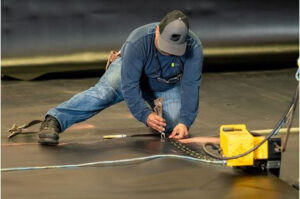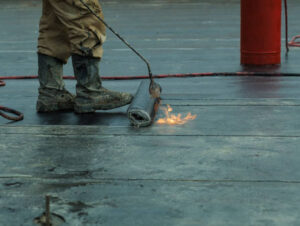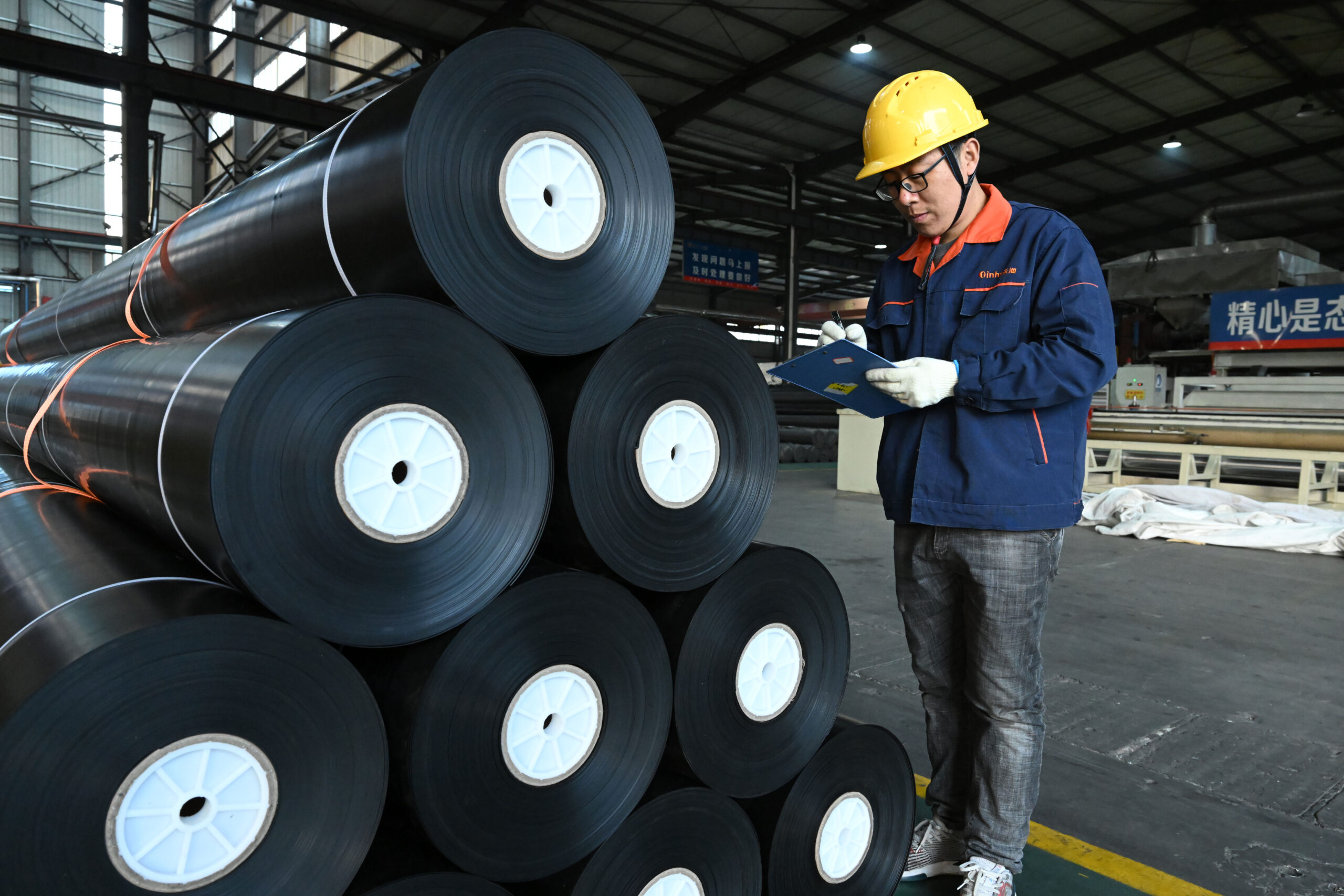HDPE geomembrane construction process
1. Process flow
●Foundation excavation
●Do lake bottom mortar protective layer (H20-30mm)
●Slope cutting, compaction and leveling
●Paste composite geomembrane and vertical retaining wall
●Basal surface leveling, cleaning, process handover
●Seal and stop water at the mouth of the underwater water pipe
●Composite geomembrane laying and welding
●Process handover
●Welding and repair quality inspection
●Completion acceptance
2. Project overview
1. The highest design water level: about 0.6m.
2. The total area of waterproof construction is about 800㎡.
3. The retaining wall is built with ceramsite bricks.
4. There are collapse pits underwater.
3. Main waterproof materials
1. Composite HDPE geomembrane coil, specification: 50*4m; 150g/㎡/0.5mm/150g/㎡.
2. GB rubber waterstop.

4. Basic conditions
1. After foundation shaping and excavation, the slope must be cut, leveled and rolled or compacted. The replacement and backfilling of the disturbed soil shall be watered and rolled or tamped in layers, and the thickness of each layer shall be ≯400mm. Yiba seven, Lu five, five seven, three six, east eight six.
2. Remove the exposed substances on the surface of the foundation that have potential puncture hazards, such as bricks, stones, tiles; glass and metal debris; branches, plant roots, etc. Clear obstacles in the field and provide necessary paving construction conditions.
3. The surrounding retaining walls, pump pits, bridge foundations, and the installation and reservation of underwater nozzles must be completed before the construction of the composite hdpe geomembrane sheets.
5. Welding and laying technology
1. Welding technology
①Weld bead lap width: 80~100mm; natural folds on the plane and vertical surfaces: 5%~8% respectively; reserved expansion and contraction: 3%~5%; leftovers: 2%~5%.
②The working temperature of hot melt welding is 280~300℃; the traveling speed is 2~3m/min; the welding form is double welding pass.
③The method of repairing the damaged part is to cut out materials with the same specifications, hot-melt and glue them, and seal them with polyethylene glue.
④ There is no fabric-like connection at the weld bead, and mechanical stitching is used.
⑤ The sealing and water-stopping of the underwater nozzle is sealed with GB rubber water-stop strips, metal wrapping and anti-corrosion treatment.

Laying technology
① Composite geomembrane sheets laying and deployment direction, from E to W or from W to E, each laying length, including the height of the retaining walls on both sides, is completed at one time.
② Laying sequence, advancing from the channel axis to both sides of S and N.
③Construction process, first make the mortar protective layer (20-30mm) of the composite hdpe geomembrane geomembrane at the bottom of the lake, and then paste it with the vertical retaining wall.
④Pasting process of composite geomembrane and retaining wall. Brush the adhesive on the bonding surface of the composite geomembrane and the retaining wall, let it dry for about 5 minutes, and then paste, squeeze, and flatten it. The adhesive is made by mixing asphalt latex paint, cement and water. After the pasting is completed, the brazing nails are anchored above the water level and treated with waterproof and anti-corrosion treatment.
6. Quality acceptance
1. The material and construction of the composite geomembrane follow the national standards for polyethylene geomembrane and composite geomembrane issued by the State Administration of Quality and Technical Supervision.
2. The construction quality inspection is divided into self-inspection by the construction unit and random inspection by the contractor.
3. Welding quality inspection adopts “inflatable pressure method” and “visual inspection method” is used for damage repair. The inflation pressure detection index is 0.06Mpa.
4. The quality acceptance process includes process handover procedures, completion acceptance, etc.
5. Normal leakage of artificial lake: ≤15mm/24h (including seasonal evaporation loss).
7. Construction progress
1. Daily efficiency, the construction area of a unit is 2000~2500㎡ per day.
2. The planned construction period is 3 days.
Suggestions
1. Strengthen the protection and management of the finished composite geomembrane, improve the waterproof awareness of relevant construction personnel, and put it into normal operation on schedule to ensure the quality of the project. is of great significance.
2. It is suggested that the contractor should notify and send special personnel to supervise. Construction personnel related to waterproof materials find that the composite geomembrane is damaged, and they should promptly notify the waterproof construction personnel to repair it.
3. The composite hdpe geomembrane liners must prevent oil from sticking, otherwise it will reduce the bonding strength. Storage and protection “See Introduction to Geomembrane Construction Methods”.
4. It is recommended that this project pay attention to the following links:
① After the composite geomembrane is welded into a finished product, a protective layer of lake bottom mortar must be made first.
② The bridge foundation is waterproof, adopting the steel bar through-membrane welding method, and the mortar protective layer is used to prevent quality hazards caused by electric welding.
③The paste of the composite HDPE geomembrane and the wall must prevent the appearance of large-scale hollowing
hdpe geomembrane specifications
| serial number | project | Index | ||||
| LDPE | LLDPE | EVA | HDPE | |||
| 1 | Thickness mm | 0.2-3.0 | 0.2-3.0 | 0.2-4.0 | 0.2-4.0 | |
| 2 | Width m | 2.5-9.0 | 2.5-9.0 | 2.5-8.0 | 2.5-8.0 | |
| 3 | Tensile strength (vertical and horizontal) Mpa | >=14 | >=16 | >=16 | >=17 | >=25 |
| 4 | Elongation at break (vertical and horizontal) % | >=400 | >=700 | >=550 | >=450 | >=550 |
| 5 | Right angle tear strength N/mm | >=50 | >=60 | >=60 | >=80 | >=110 |
| 6 | Water vapor permeability coefficient g. cm/c㎡.s. pa | <1.0*10 | <1.0*10 | <1.0*10 | ——— | ——— |
| 7 | Operating temperature range | +70℃﹋-70℃ | +70℃﹋-70℃ | +70℃﹋-70℃ | ——— | ——— |
| 8 | Carbon black content% | ——— | ——— | ——— | 2.0-3.0 | |
| 9 | Environmental Stress Cracking Resistance F | ——— | ——— | ——— | >=1500 | |
| 10 | -70℃ low temperature impact embrittlement performance | ——— | ——— | ——— | pass | |
| 11 | Oxidation induction time at 200°C | ——— | ——— |
[wpforms id=”40″]
Author
-

Founded in 2002, Tinhy's team focuses on the manufacturing, marketing, installation, application and research and development of geosynthetic materials.
View all posts




